Instacart's Grocery Business Model: Competitive Analysis and IT Role
VerifiedAdded on 2022/09/18
|12
|3025
|19
Case Study
AI Summary
This case study analyzes Instacart's business model, focusing on its competitive advantages in the online grocery market. It explores the application of Porter's Five Forces to understand the competitive landscape, the value proposition for both customers and grocery retailers, and the revenue generation strategies employed. The analysis highlights Instacart's innovative approach to online grocery shopping, including its unique model of not owning warehouses and its integration of IT to manage inventories, facilitate customer ordering, and implement digital marketing strategies. The study also assesses the viability of Instacart's business model, emphasizing its customer-centric services and the benefits it offers to local grocers, thereby serving both B2B and B2C purposes. The report discusses the role of IT systems in the business and its contribution to enhancing business operations. The case study further provides an overview of the advantages that the company has obtained by providing a platform to the local grocery stores and food suppliers, and the benefits of providing the customers the flexibility to choose their products from multiple vendors.
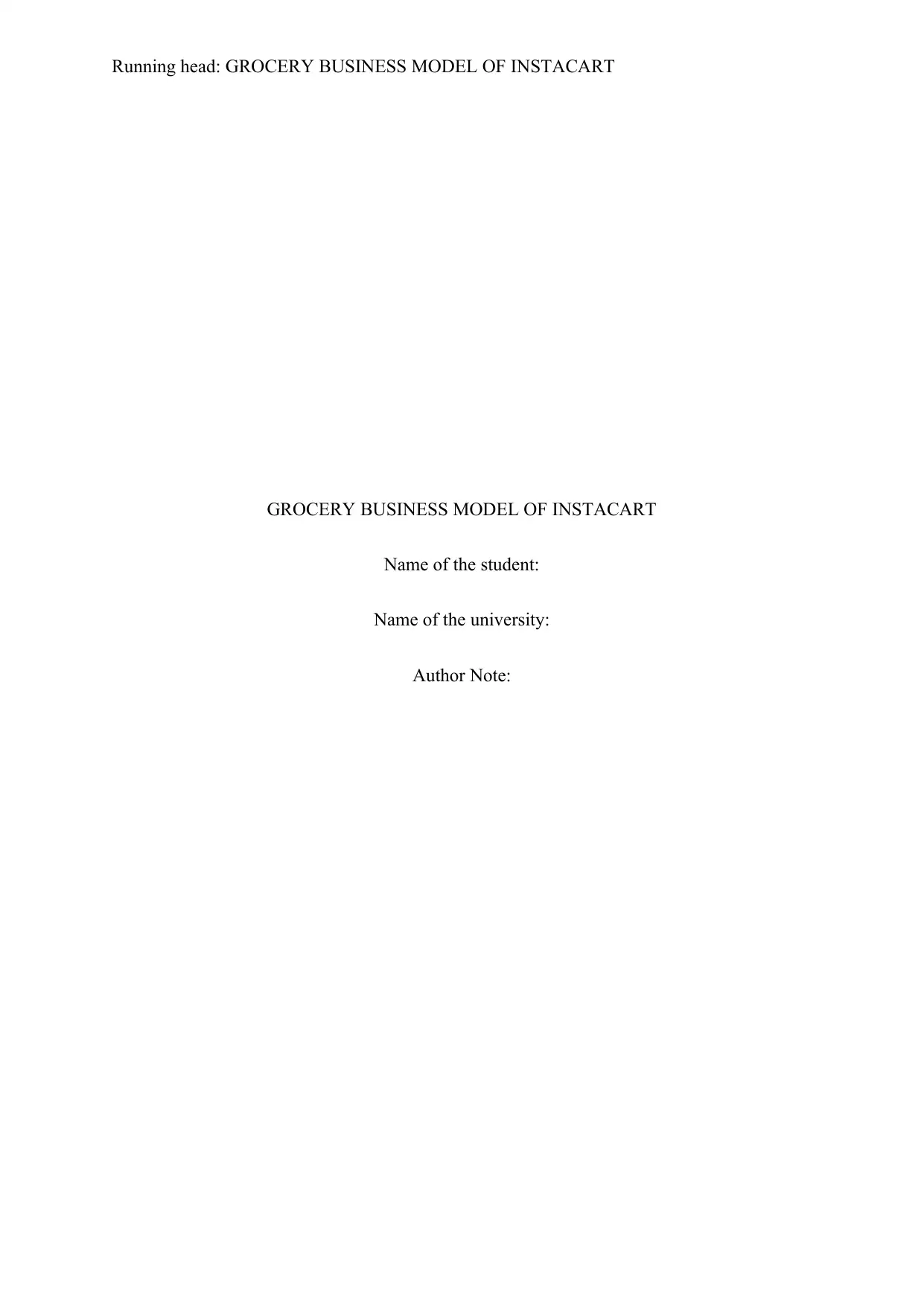
Running head: GROCERY BUSINESS MODEL OF INSTACART
GROCERY BUSINESS MODEL OF INSTACART
Name of the student:
Name of the university:
Author Note:
GROCERY BUSINESS MODEL OF INSTACART
Name of the student:
Name of the university:
Author Note:
Paraphrase This Document
Need a fresh take? Get an instant paraphrase of this document with our AI Paraphraser
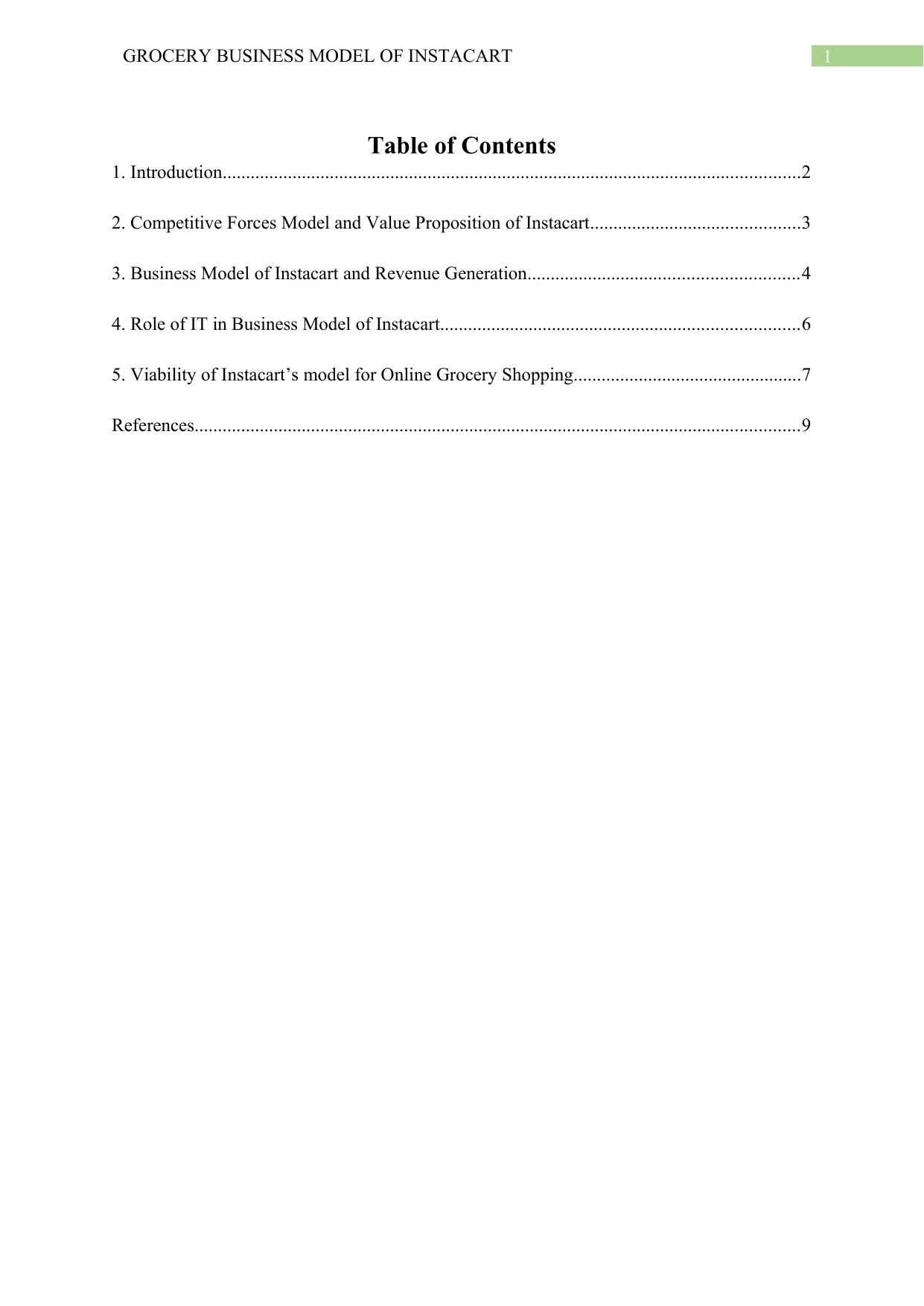
1GROCERY BUSINESS MODEL OF INSTACART
Table of Contents
1. Introduction............................................................................................................................2
2. Competitive Forces Model and Value Proposition of Instacart.............................................3
3. Business Model of Instacart and Revenue Generation..........................................................4
4. Role of IT in Business Model of Instacart.............................................................................6
5. Viability of Instacart’s model for Online Grocery Shopping.................................................7
References..................................................................................................................................9
Table of Contents
1. Introduction............................................................................................................................2
2. Competitive Forces Model and Value Proposition of Instacart.............................................3
3. Business Model of Instacart and Revenue Generation..........................................................4
4. Role of IT in Business Model of Instacart.............................................................................6
5. Viability of Instacart’s model for Online Grocery Shopping.................................................7
References..................................................................................................................................9
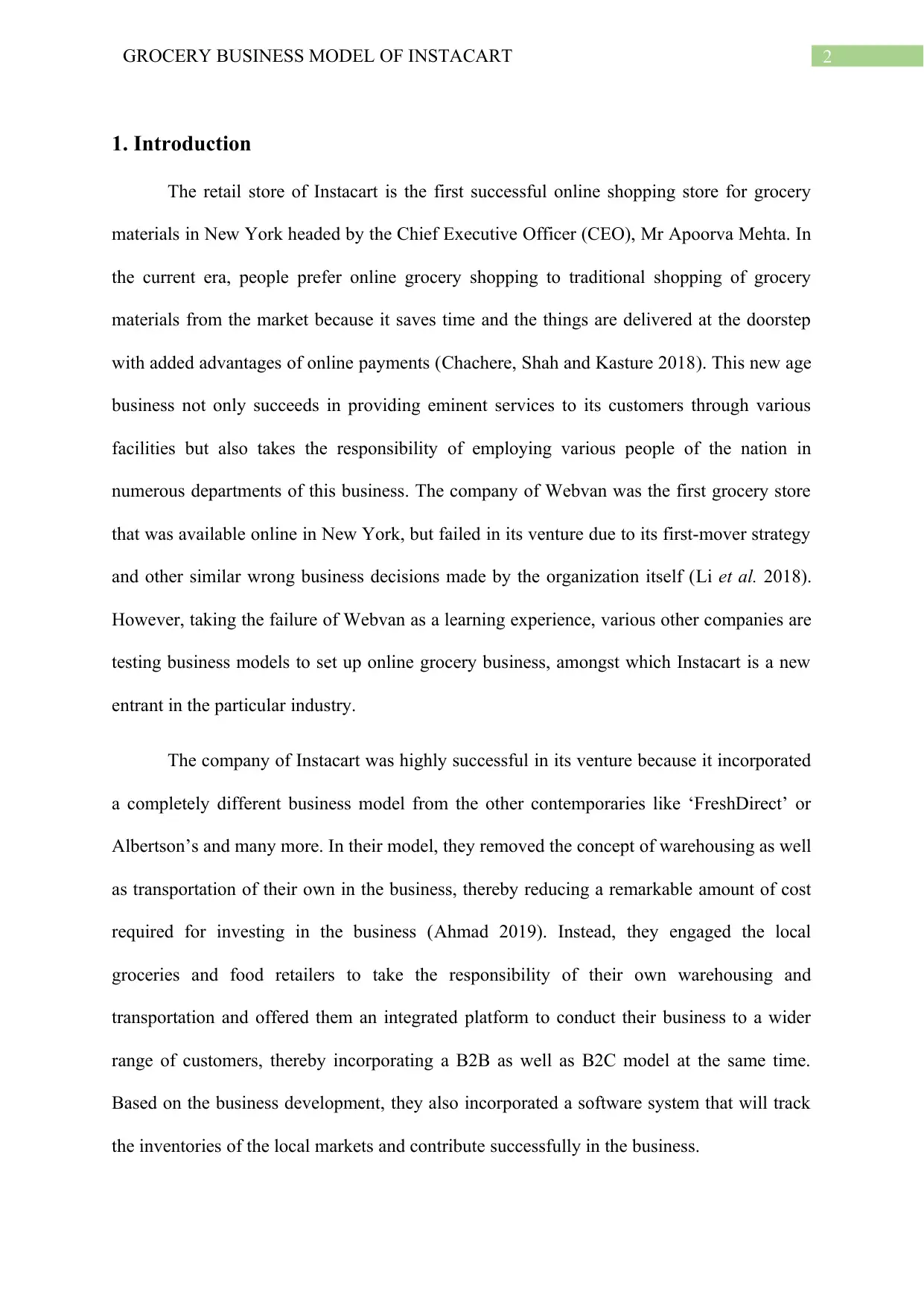
2GROCERY BUSINESS MODEL OF INSTACART
1. Introduction
The retail store of Instacart is the first successful online shopping store for grocery
materials in New York headed by the Chief Executive Officer (CEO), Mr Apoorva Mehta. In
the current era, people prefer online grocery shopping to traditional shopping of grocery
materials from the market because it saves time and the things are delivered at the doorstep
with added advantages of online payments (Chachere, Shah and Kasture 2018). This new age
business not only succeeds in providing eminent services to its customers through various
facilities but also takes the responsibility of employing various people of the nation in
numerous departments of this business. The company of Webvan was the first grocery store
that was available online in New York, but failed in its venture due to its first-mover strategy
and other similar wrong business decisions made by the organization itself (Li et al. 2018).
However, taking the failure of Webvan as a learning experience, various other companies are
testing business models to set up online grocery business, amongst which Instacart is a new
entrant in the particular industry.
The company of Instacart was highly successful in its venture because it incorporated
a completely different business model from the other contemporaries like ‘FreshDirect’ or
Albertson’s and many more. In their model, they removed the concept of warehousing as well
as transportation of their own in the business, thereby reducing a remarkable amount of cost
required for investing in the business (Ahmad 2019). Instead, they engaged the local
groceries and food retailers to take the responsibility of their own warehousing and
transportation and offered them an integrated platform to conduct their business to a wider
range of customers, thereby incorporating a B2B as well as B2C model at the same time.
Based on the business development, they also incorporated a software system that will track
the inventories of the local markets and contribute successfully in the business.
1. Introduction
The retail store of Instacart is the first successful online shopping store for grocery
materials in New York headed by the Chief Executive Officer (CEO), Mr Apoorva Mehta. In
the current era, people prefer online grocery shopping to traditional shopping of grocery
materials from the market because it saves time and the things are delivered at the doorstep
with added advantages of online payments (Chachere, Shah and Kasture 2018). This new age
business not only succeeds in providing eminent services to its customers through various
facilities but also takes the responsibility of employing various people of the nation in
numerous departments of this business. The company of Webvan was the first grocery store
that was available online in New York, but failed in its venture due to its first-mover strategy
and other similar wrong business decisions made by the organization itself (Li et al. 2018).
However, taking the failure of Webvan as a learning experience, various other companies are
testing business models to set up online grocery business, amongst which Instacart is a new
entrant in the particular industry.
The company of Instacart was highly successful in its venture because it incorporated
a completely different business model from the other contemporaries like ‘FreshDirect’ or
Albertson’s and many more. In their model, they removed the concept of warehousing as well
as transportation of their own in the business, thereby reducing a remarkable amount of cost
required for investing in the business (Ahmad 2019). Instead, they engaged the local
groceries and food retailers to take the responsibility of their own warehousing and
transportation and offered them an integrated platform to conduct their business to a wider
range of customers, thereby incorporating a B2B as well as B2C model at the same time.
Based on the business development, they also incorporated a software system that will track
the inventories of the local markets and contribute successfully in the business.
⊘ This is a preview!⊘
Do you want full access?
Subscribe today to unlock all pages.

Trusted by 1+ million students worldwide
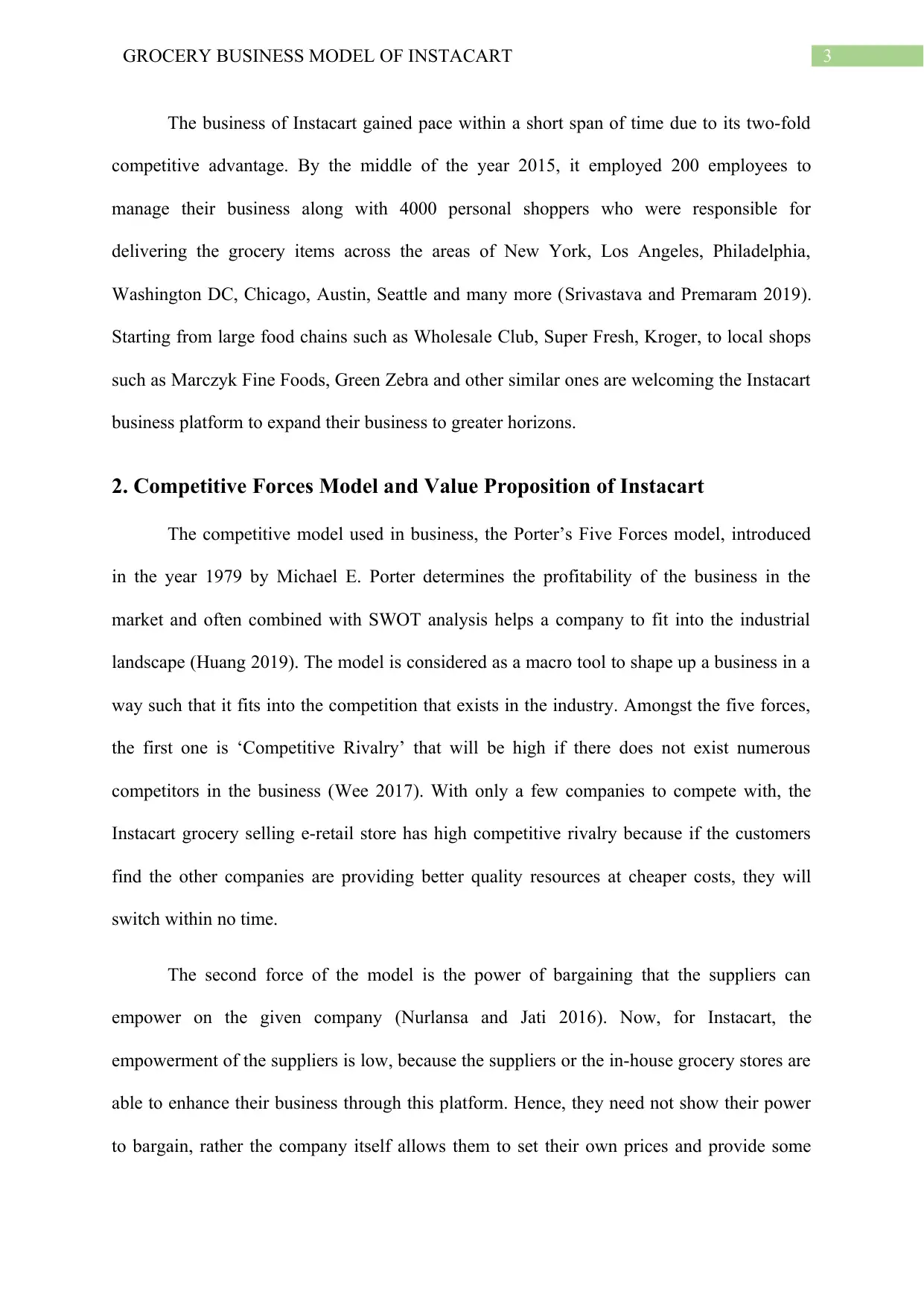
3GROCERY BUSINESS MODEL OF INSTACART
The business of Instacart gained pace within a short span of time due to its two-fold
competitive advantage. By the middle of the year 2015, it employed 200 employees to
manage their business along with 4000 personal shoppers who were responsible for
delivering the grocery items across the areas of New York, Los Angeles, Philadelphia,
Washington DC, Chicago, Austin, Seattle and many more (Srivastava and Premaram 2019).
Starting from large food chains such as Wholesale Club, Super Fresh, Kroger, to local shops
such as Marczyk Fine Foods, Green Zebra and other similar ones are welcoming the Instacart
business platform to expand their business to greater horizons.
2. Competitive Forces Model and Value Proposition of Instacart
The competitive model used in business, the Porter’s Five Forces model, introduced
in the year 1979 by Michael E. Porter determines the profitability of the business in the
market and often combined with SWOT analysis helps a company to fit into the industrial
landscape (Huang 2019). The model is considered as a macro tool to shape up a business in a
way such that it fits into the competition that exists in the industry. Amongst the five forces,
the first one is ‘Competitive Rivalry’ that will be high if there does not exist numerous
competitors in the business (Wee 2017). With only a few companies to compete with, the
Instacart grocery selling e-retail store has high competitive rivalry because if the customers
find the other companies are providing better quality resources at cheaper costs, they will
switch within no time.
The second force of the model is the power of bargaining that the suppliers can
empower on the given company (Nurlansa and Jati 2016). Now, for Instacart, the
empowerment of the suppliers is low, because the suppliers or the in-house grocery stores are
able to enhance their business through this platform. Hence, they need not show their power
to bargain, rather the company itself allows them to set their own prices and provide some
The business of Instacart gained pace within a short span of time due to its two-fold
competitive advantage. By the middle of the year 2015, it employed 200 employees to
manage their business along with 4000 personal shoppers who were responsible for
delivering the grocery items across the areas of New York, Los Angeles, Philadelphia,
Washington DC, Chicago, Austin, Seattle and many more (Srivastava and Premaram 2019).
Starting from large food chains such as Wholesale Club, Super Fresh, Kroger, to local shops
such as Marczyk Fine Foods, Green Zebra and other similar ones are welcoming the Instacart
business platform to expand their business to greater horizons.
2. Competitive Forces Model and Value Proposition of Instacart
The competitive model used in business, the Porter’s Five Forces model, introduced
in the year 1979 by Michael E. Porter determines the profitability of the business in the
market and often combined with SWOT analysis helps a company to fit into the industrial
landscape (Huang 2019). The model is considered as a macro tool to shape up a business in a
way such that it fits into the competition that exists in the industry. Amongst the five forces,
the first one is ‘Competitive Rivalry’ that will be high if there does not exist numerous
competitors in the business (Wee 2017). With only a few companies to compete with, the
Instacart grocery selling e-retail store has high competitive rivalry because if the customers
find the other companies are providing better quality resources at cheaper costs, they will
switch within no time.
The second force of the model is the power of bargaining that the suppliers can
empower on the given company (Nurlansa and Jati 2016). Now, for Instacart, the
empowerment of the suppliers is low, because the suppliers or the in-house grocery stores are
able to enhance their business through this platform. Hence, they need not show their power
to bargain, rather the company itself allows them to set their own prices and provide some
Paraphrase This Document
Need a fresh take? Get an instant paraphrase of this document with our AI Paraphraser
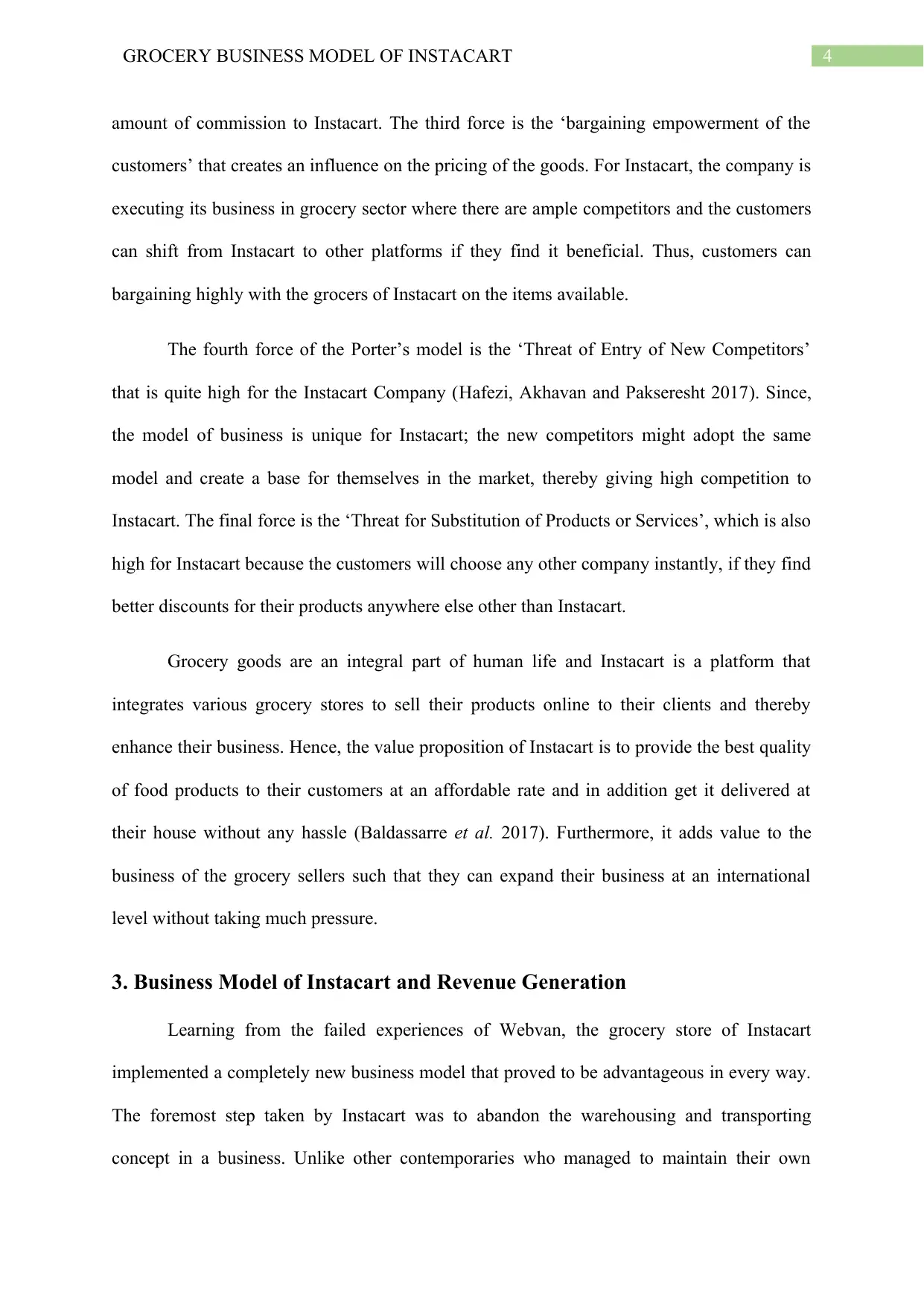
4GROCERY BUSINESS MODEL OF INSTACART
amount of commission to Instacart. The third force is the ‘bargaining empowerment of the
customers’ that creates an influence on the pricing of the goods. For Instacart, the company is
executing its business in grocery sector where there are ample competitors and the customers
can shift from Instacart to other platforms if they find it beneficial. Thus, customers can
bargaining highly with the grocers of Instacart on the items available.
The fourth force of the Porter’s model is the ‘Threat of Entry of New Competitors’
that is quite high for the Instacart Company (Hafezi, Akhavan and Pakseresht 2017). Since,
the model of business is unique for Instacart; the new competitors might adopt the same
model and create a base for themselves in the market, thereby giving high competition to
Instacart. The final force is the ‘Threat for Substitution of Products or Services’, which is also
high for Instacart because the customers will choose any other company instantly, if they find
better discounts for their products anywhere else other than Instacart.
Grocery goods are an integral part of human life and Instacart is a platform that
integrates various grocery stores to sell their products online to their clients and thereby
enhance their business. Hence, the value proposition of Instacart is to provide the best quality
of food products to their customers at an affordable rate and in addition get it delivered at
their house without any hassle (Baldassarre et al. 2017). Furthermore, it adds value to the
business of the grocery sellers such that they can expand their business at an international
level without taking much pressure.
3. Business Model of Instacart and Revenue Generation
Learning from the failed experiences of Webvan, the grocery store of Instacart
implemented a completely new business model that proved to be advantageous in every way.
The foremost step taken by Instacart was to abandon the warehousing and transporting
concept in a business. Unlike other contemporaries who managed to maintain their own
amount of commission to Instacart. The third force is the ‘bargaining empowerment of the
customers’ that creates an influence on the pricing of the goods. For Instacart, the company is
executing its business in grocery sector where there are ample competitors and the customers
can shift from Instacart to other platforms if they find it beneficial. Thus, customers can
bargaining highly with the grocers of Instacart on the items available.
The fourth force of the Porter’s model is the ‘Threat of Entry of New Competitors’
that is quite high for the Instacart Company (Hafezi, Akhavan and Pakseresht 2017). Since,
the model of business is unique for Instacart; the new competitors might adopt the same
model and create a base for themselves in the market, thereby giving high competition to
Instacart. The final force is the ‘Threat for Substitution of Products or Services’, which is also
high for Instacart because the customers will choose any other company instantly, if they find
better discounts for their products anywhere else other than Instacart.
Grocery goods are an integral part of human life and Instacart is a platform that
integrates various grocery stores to sell their products online to their clients and thereby
enhance their business. Hence, the value proposition of Instacart is to provide the best quality
of food products to their customers at an affordable rate and in addition get it delivered at
their house without any hassle (Baldassarre et al. 2017). Furthermore, it adds value to the
business of the grocery sellers such that they can expand their business at an international
level without taking much pressure.
3. Business Model of Instacart and Revenue Generation
Learning from the failed experiences of Webvan, the grocery store of Instacart
implemented a completely new business model that proved to be advantageous in every way.
The foremost step taken by Instacart was to abandon the warehousing and transporting
concept in a business. Unlike other contemporaries who managed to maintain their own
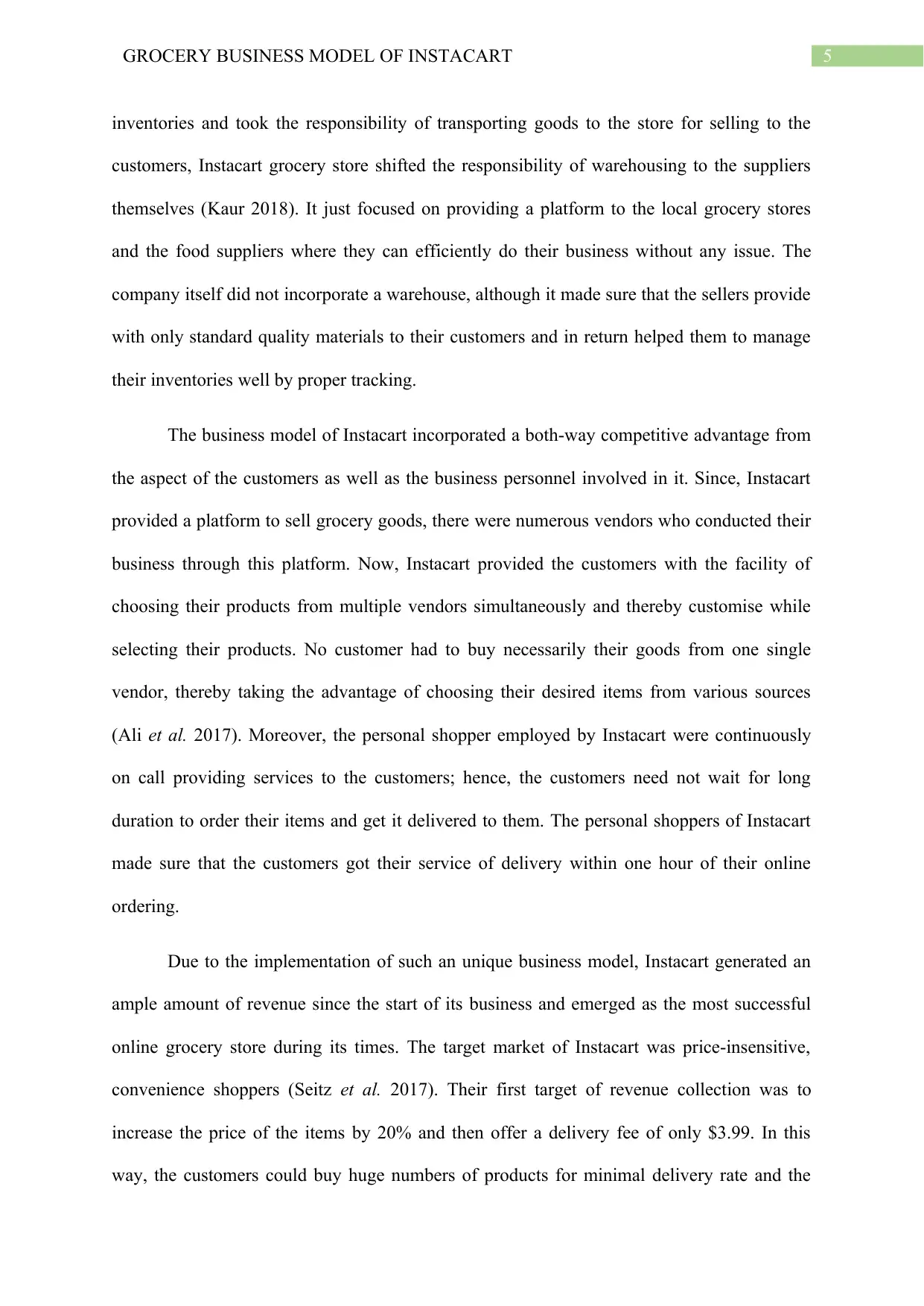
5GROCERY BUSINESS MODEL OF INSTACART
inventories and took the responsibility of transporting goods to the store for selling to the
customers, Instacart grocery store shifted the responsibility of warehousing to the suppliers
themselves (Kaur 2018). It just focused on providing a platform to the local grocery stores
and the food suppliers where they can efficiently do their business without any issue. The
company itself did not incorporate a warehouse, although it made sure that the sellers provide
with only standard quality materials to their customers and in return helped them to manage
their inventories well by proper tracking.
The business model of Instacart incorporated a both-way competitive advantage from
the aspect of the customers as well as the business personnel involved in it. Since, Instacart
provided a platform to sell grocery goods, there were numerous vendors who conducted their
business through this platform. Now, Instacart provided the customers with the facility of
choosing their products from multiple vendors simultaneously and thereby customise while
selecting their products. No customer had to buy necessarily their goods from one single
vendor, thereby taking the advantage of choosing their desired items from various sources
(Ali et al. 2017). Moreover, the personal shopper employed by Instacart were continuously
on call providing services to the customers; hence, the customers need not wait for long
duration to order their items and get it delivered to them. The personal shoppers of Instacart
made sure that the customers got their service of delivery within one hour of their online
ordering.
Due to the implementation of such an unique business model, Instacart generated an
ample amount of revenue since the start of its business and emerged as the most successful
online grocery store during its times. The target market of Instacart was price-insensitive,
convenience shoppers (Seitz et al. 2017). Their first target of revenue collection was to
increase the price of the items by 20% and then offer a delivery fee of only $3.99. In this
way, the customers could buy huge numbers of products for minimal delivery rate and the
inventories and took the responsibility of transporting goods to the store for selling to the
customers, Instacart grocery store shifted the responsibility of warehousing to the suppliers
themselves (Kaur 2018). It just focused on providing a platform to the local grocery stores
and the food suppliers where they can efficiently do their business without any issue. The
company itself did not incorporate a warehouse, although it made sure that the sellers provide
with only standard quality materials to their customers and in return helped them to manage
their inventories well by proper tracking.
The business model of Instacart incorporated a both-way competitive advantage from
the aspect of the customers as well as the business personnel involved in it. Since, Instacart
provided a platform to sell grocery goods, there were numerous vendors who conducted their
business through this platform. Now, Instacart provided the customers with the facility of
choosing their products from multiple vendors simultaneously and thereby customise while
selecting their products. No customer had to buy necessarily their goods from one single
vendor, thereby taking the advantage of choosing their desired items from various sources
(Ali et al. 2017). Moreover, the personal shopper employed by Instacart were continuously
on call providing services to the customers; hence, the customers need not wait for long
duration to order their items and get it delivered to them. The personal shoppers of Instacart
made sure that the customers got their service of delivery within one hour of their online
ordering.
Due to the implementation of such an unique business model, Instacart generated an
ample amount of revenue since the start of its business and emerged as the most successful
online grocery store during its times. The target market of Instacart was price-insensitive,
convenience shoppers (Seitz et al. 2017). Their first target of revenue collection was to
increase the price of the items by 20% and then offer a delivery fee of only $3.99. In this
way, the customers could buy huge numbers of products for minimal delivery rate and the
⊘ This is a preview!⊘
Do you want full access?
Subscribe today to unlock all pages.

Trusted by 1+ million students worldwide
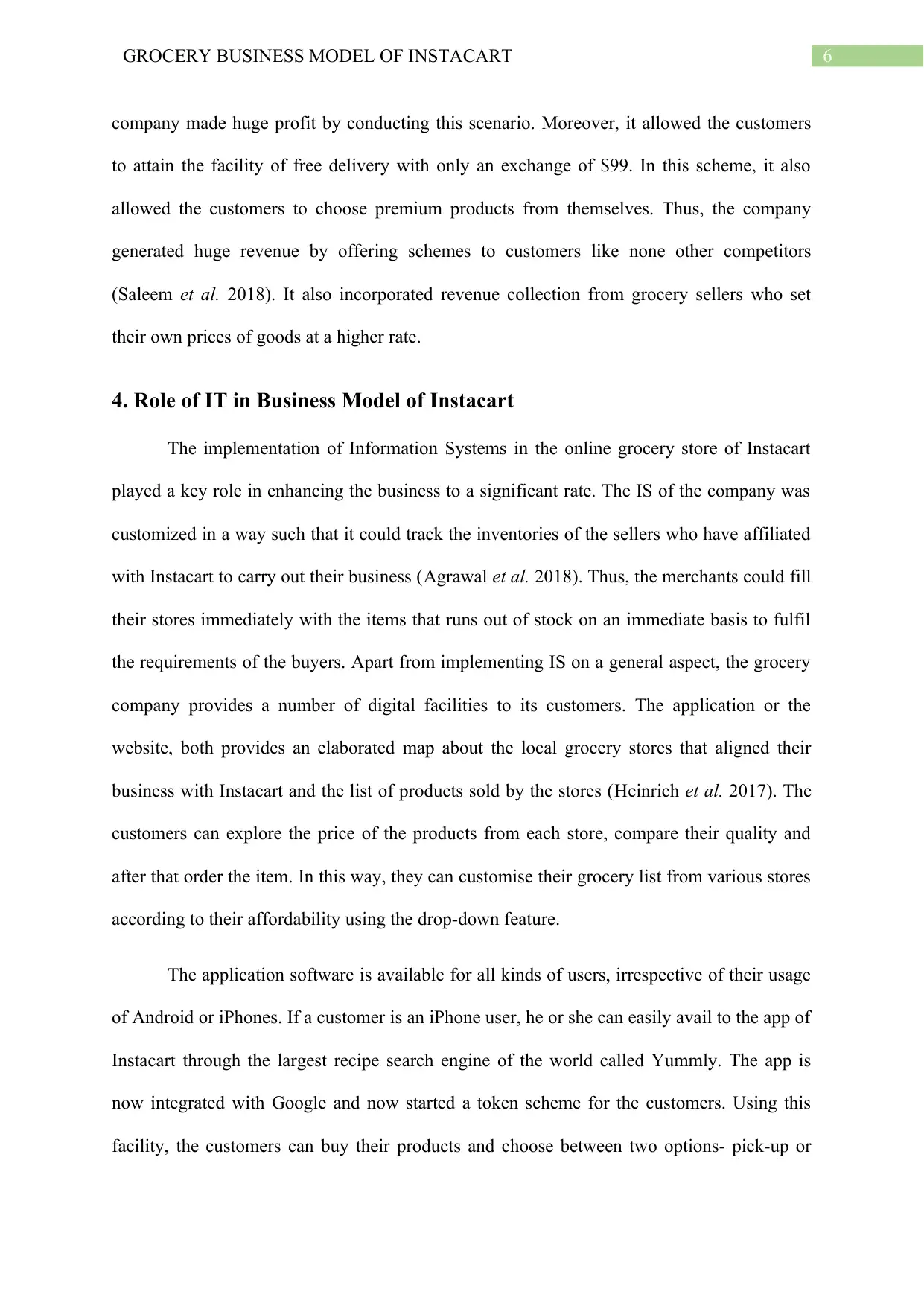
6GROCERY BUSINESS MODEL OF INSTACART
company made huge profit by conducting this scenario. Moreover, it allowed the customers
to attain the facility of free delivery with only an exchange of $99. In this scheme, it also
allowed the customers to choose premium products from themselves. Thus, the company
generated huge revenue by offering schemes to customers like none other competitors
(Saleem et al. 2018). It also incorporated revenue collection from grocery sellers who set
their own prices of goods at a higher rate.
4. Role of IT in Business Model of Instacart
The implementation of Information Systems in the online grocery store of Instacart
played a key role in enhancing the business to a significant rate. The IS of the company was
customized in a way such that it could track the inventories of the sellers who have affiliated
with Instacart to carry out their business (Agrawal et al. 2018). Thus, the merchants could fill
their stores immediately with the items that runs out of stock on an immediate basis to fulfil
the requirements of the buyers. Apart from implementing IS on a general aspect, the grocery
company provides a number of digital facilities to its customers. The application or the
website, both provides an elaborated map about the local grocery stores that aligned their
business with Instacart and the list of products sold by the stores (Heinrich et al. 2017). The
customers can explore the price of the products from each store, compare their quality and
after that order the item. In this way, they can customise their grocery list from various stores
according to their affordability using the drop-down feature.
The application software is available for all kinds of users, irrespective of their usage
of Android or iPhones. If a customer is an iPhone user, he or she can easily avail to the app of
Instacart through the largest recipe search engine of the world called Yummly. The app is
now integrated with Google and now started a token scheme for the customers. Using this
facility, the customers can buy their products and choose between two options- pick-up or
company made huge profit by conducting this scenario. Moreover, it allowed the customers
to attain the facility of free delivery with only an exchange of $99. In this scheme, it also
allowed the customers to choose premium products from themselves. Thus, the company
generated huge revenue by offering schemes to customers like none other competitors
(Saleem et al. 2018). It also incorporated revenue collection from grocery sellers who set
their own prices of goods at a higher rate.
4. Role of IT in Business Model of Instacart
The implementation of Information Systems in the online grocery store of Instacart
played a key role in enhancing the business to a significant rate. The IS of the company was
customized in a way such that it could track the inventories of the sellers who have affiliated
with Instacart to carry out their business (Agrawal et al. 2018). Thus, the merchants could fill
their stores immediately with the items that runs out of stock on an immediate basis to fulfil
the requirements of the buyers. Apart from implementing IS on a general aspect, the grocery
company provides a number of digital facilities to its customers. The application or the
website, both provides an elaborated map about the local grocery stores that aligned their
business with Instacart and the list of products sold by the stores (Heinrich et al. 2017). The
customers can explore the price of the products from each store, compare their quality and
after that order the item. In this way, they can customise their grocery list from various stores
according to their affordability using the drop-down feature.
The application software is available for all kinds of users, irrespective of their usage
of Android or iPhones. If a customer is an iPhone user, he or she can easily avail to the app of
Instacart through the largest recipe search engine of the world called Yummly. The app is
now integrated with Google and now started a token scheme for the customers. Using this
facility, the customers can buy their products and choose between two options- pick-up or
Paraphrase This Document
Need a fresh take? Get an instant paraphrase of this document with our AI Paraphraser
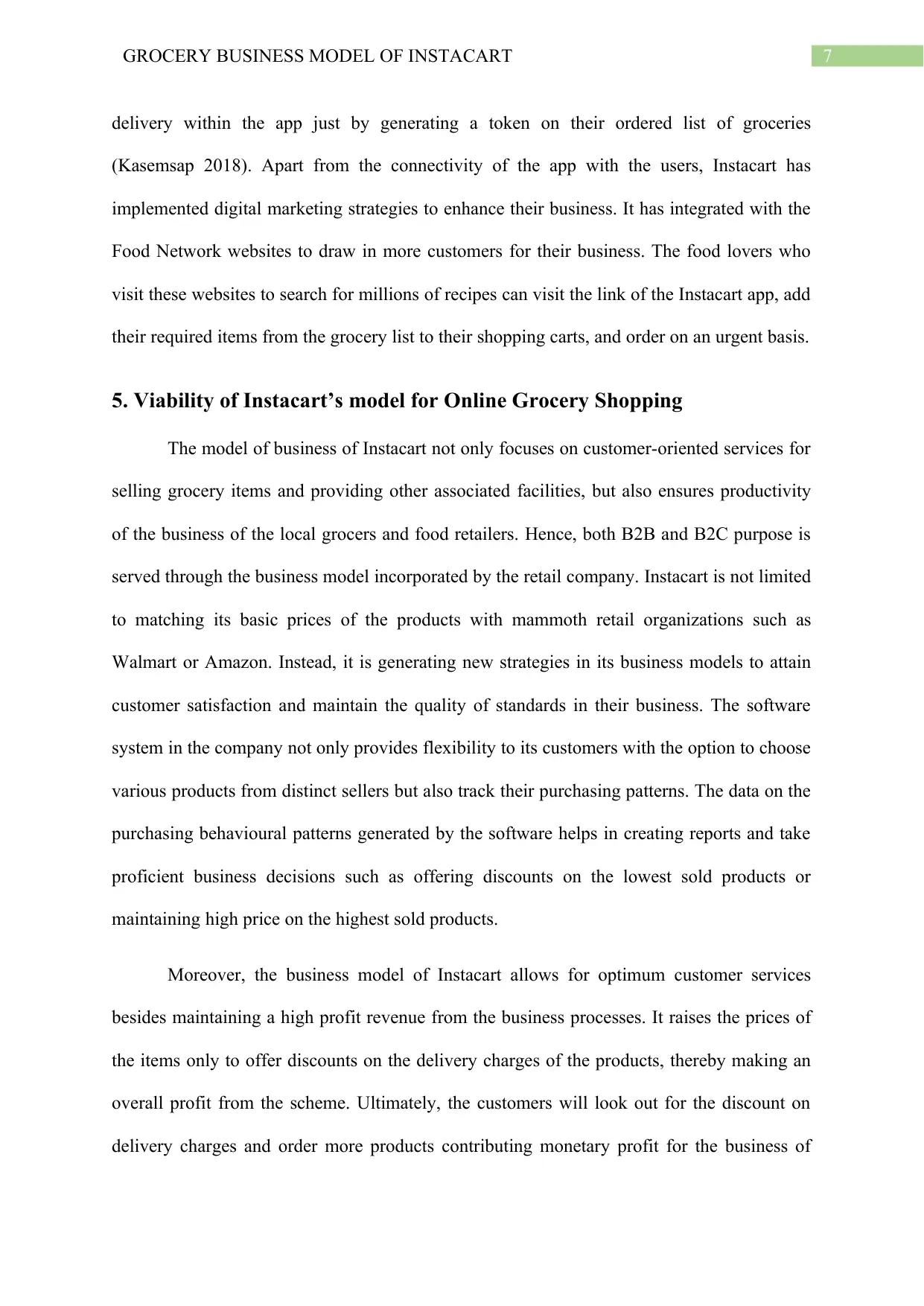
7GROCERY BUSINESS MODEL OF INSTACART
delivery within the app just by generating a token on their ordered list of groceries
(Kasemsap 2018). Apart from the connectivity of the app with the users, Instacart has
implemented digital marketing strategies to enhance their business. It has integrated with the
Food Network websites to draw in more customers for their business. The food lovers who
visit these websites to search for millions of recipes can visit the link of the Instacart app, add
their required items from the grocery list to their shopping carts, and order on an urgent basis.
5. Viability of Instacart’s model for Online Grocery Shopping
The model of business of Instacart not only focuses on customer-oriented services for
selling grocery items and providing other associated facilities, but also ensures productivity
of the business of the local grocers and food retailers. Hence, both B2B and B2C purpose is
served through the business model incorporated by the retail company. Instacart is not limited
to matching its basic prices of the products with mammoth retail organizations such as
Walmart or Amazon. Instead, it is generating new strategies in its business models to attain
customer satisfaction and maintain the quality of standards in their business. The software
system in the company not only provides flexibility to its customers with the option to choose
various products from distinct sellers but also track their purchasing patterns. The data on the
purchasing behavioural patterns generated by the software helps in creating reports and take
proficient business decisions such as offering discounts on the lowest sold products or
maintaining high price on the highest sold products.
Moreover, the business model of Instacart allows for optimum customer services
besides maintaining a high profit revenue from the business processes. It raises the prices of
the items only to offer discounts on the delivery charges of the products, thereby making an
overall profit from the scheme. Ultimately, the customers will look out for the discount on
delivery charges and order more products contributing monetary profit for the business of
delivery within the app just by generating a token on their ordered list of groceries
(Kasemsap 2018). Apart from the connectivity of the app with the users, Instacart has
implemented digital marketing strategies to enhance their business. It has integrated with the
Food Network websites to draw in more customers for their business. The food lovers who
visit these websites to search for millions of recipes can visit the link of the Instacart app, add
their required items from the grocery list to their shopping carts, and order on an urgent basis.
5. Viability of Instacart’s model for Online Grocery Shopping
The model of business of Instacart not only focuses on customer-oriented services for
selling grocery items and providing other associated facilities, but also ensures productivity
of the business of the local grocers and food retailers. Hence, both B2B and B2C purpose is
served through the business model incorporated by the retail company. Instacart is not limited
to matching its basic prices of the products with mammoth retail organizations such as
Walmart or Amazon. Instead, it is generating new strategies in its business models to attain
customer satisfaction and maintain the quality of standards in their business. The software
system in the company not only provides flexibility to its customers with the option to choose
various products from distinct sellers but also track their purchasing patterns. The data on the
purchasing behavioural patterns generated by the software helps in creating reports and take
proficient business decisions such as offering discounts on the lowest sold products or
maintaining high price on the highest sold products.
Moreover, the business model of Instacart allows for optimum customer services
besides maintaining a high profit revenue from the business processes. It raises the prices of
the items only to offer discounts on the delivery charges of the products, thereby making an
overall profit from the scheme. Ultimately, the customers will look out for the discount on
delivery charges and order more products contributing monetary profit for the business of
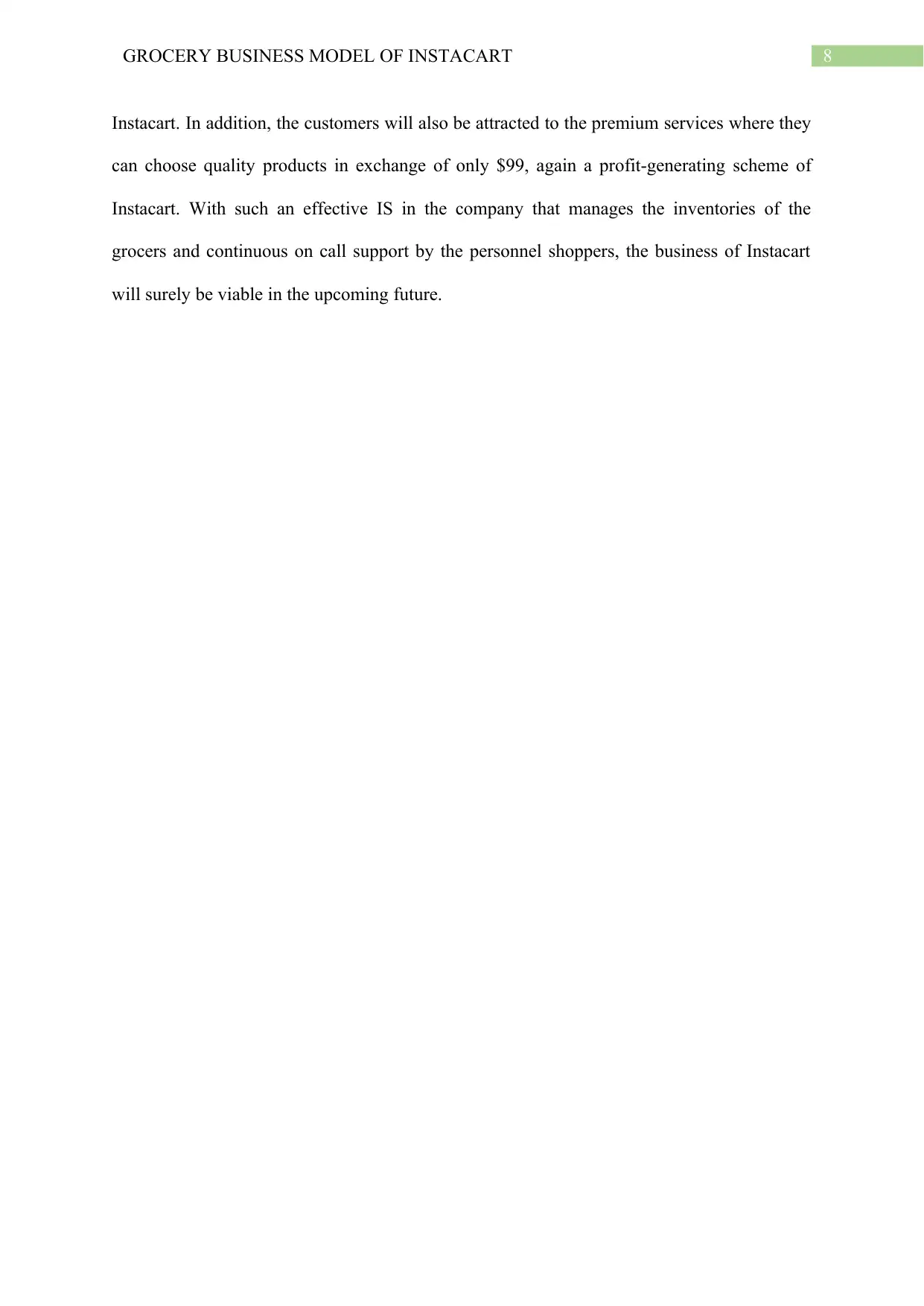
8GROCERY BUSINESS MODEL OF INSTACART
Instacart. In addition, the customers will also be attracted to the premium services where they
can choose quality products in exchange of only $99, again a profit-generating scheme of
Instacart. With such an effective IS in the company that manages the inventories of the
grocers and continuous on call support by the personnel shoppers, the business of Instacart
will surely be viable in the upcoming future.
Instacart. In addition, the customers will also be attracted to the premium services where they
can choose quality products in exchange of only $99, again a profit-generating scheme of
Instacart. With such an effective IS in the company that manages the inventories of the
grocers and continuous on call support by the personnel shoppers, the business of Instacart
will surely be viable in the upcoming future.
⊘ This is a preview!⊘
Do you want full access?
Subscribe today to unlock all pages.

Trusted by 1+ million students worldwide
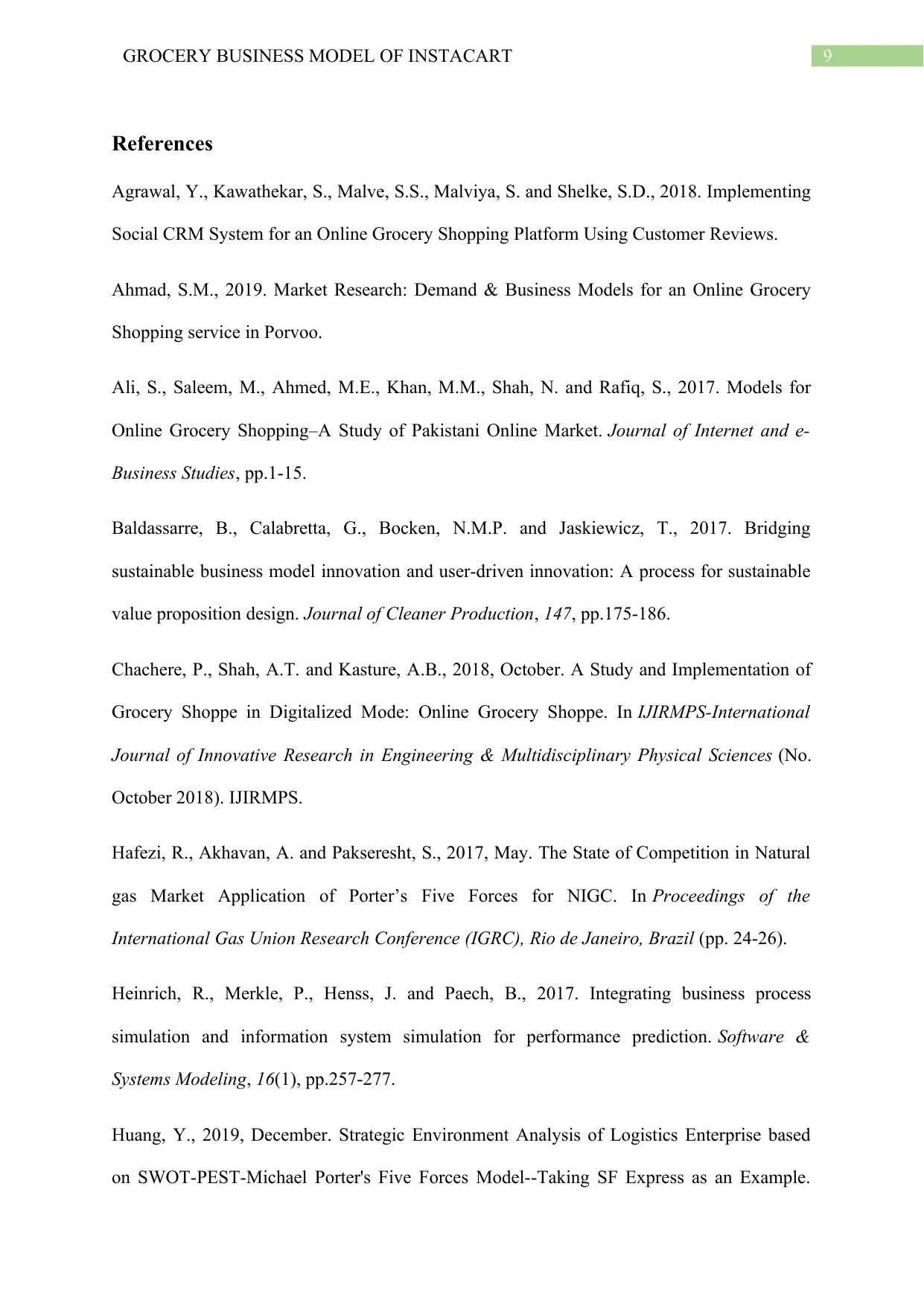
9GROCERY BUSINESS MODEL OF INSTACART
References
Agrawal, Y., Kawathekar, S., Malve, S.S., Malviya, S. and Shelke, S.D., 2018. Implementing
Social CRM System for an Online Grocery Shopping Platform Using Customer Reviews.
Ahmad, S.M., 2019. Market Research: Demand & Business Models for an Online Grocery
Shopping service in Porvoo.
Ali, S., Saleem, M., Ahmed, M.E., Khan, M.M., Shah, N. and Rafiq, S., 2017. Models for
Online Grocery Shopping–A Study of Pakistani Online Market. Journal of Internet and e-
Business Studies, pp.1-15.
Baldassarre, B., Calabretta, G., Bocken, N.M.P. and Jaskiewicz, T., 2017. Bridging
sustainable business model innovation and user-driven innovation: A process for sustainable
value proposition design. Journal of Cleaner Production, 147, pp.175-186.
Chachere, P., Shah, A.T. and Kasture, A.B., 2018, October. A Study and Implementation of
Grocery Shoppe in Digitalized Mode: Online Grocery Shoppe. In IJIRMPS-International
Journal of Innovative Research in Engineering & Multidisciplinary Physical Sciences (No.
October 2018). IJIRMPS.
Hafezi, R., Akhavan, A. and Pakseresht, S., 2017, May. The State of Competition in Natural
gas Market Application of Porter’s Five Forces for NIGC. In Proceedings of the
International Gas Union Research Conference (IGRC), Rio de Janeiro, Brazil (pp. 24-26).
Heinrich, R., Merkle, P., Henss, J. and Paech, B., 2017. Integrating business process
simulation and information system simulation for performance prediction. Software &
Systems Modeling, 16(1), pp.257-277.
Huang, Y., 2019, December. Strategic Environment Analysis of Logistics Enterprise based
on SWOT-PEST-Michael Porter's Five Forces Model--Taking SF Express as an Example.
References
Agrawal, Y., Kawathekar, S., Malve, S.S., Malviya, S. and Shelke, S.D., 2018. Implementing
Social CRM System for an Online Grocery Shopping Platform Using Customer Reviews.
Ahmad, S.M., 2019. Market Research: Demand & Business Models for an Online Grocery
Shopping service in Porvoo.
Ali, S., Saleem, M., Ahmed, M.E., Khan, M.M., Shah, N. and Rafiq, S., 2017. Models for
Online Grocery Shopping–A Study of Pakistani Online Market. Journal of Internet and e-
Business Studies, pp.1-15.
Baldassarre, B., Calabretta, G., Bocken, N.M.P. and Jaskiewicz, T., 2017. Bridging
sustainable business model innovation and user-driven innovation: A process for sustainable
value proposition design. Journal of Cleaner Production, 147, pp.175-186.
Chachere, P., Shah, A.T. and Kasture, A.B., 2018, October. A Study and Implementation of
Grocery Shoppe in Digitalized Mode: Online Grocery Shoppe. In IJIRMPS-International
Journal of Innovative Research in Engineering & Multidisciplinary Physical Sciences (No.
October 2018). IJIRMPS.
Hafezi, R., Akhavan, A. and Pakseresht, S., 2017, May. The State of Competition in Natural
gas Market Application of Porter’s Five Forces for NIGC. In Proceedings of the
International Gas Union Research Conference (IGRC), Rio de Janeiro, Brazil (pp. 24-26).
Heinrich, R., Merkle, P., Henss, J. and Paech, B., 2017. Integrating business process
simulation and information system simulation for performance prediction. Software &
Systems Modeling, 16(1), pp.257-277.
Huang, Y., 2019, December. Strategic Environment Analysis of Logistics Enterprise based
on SWOT-PEST-Michael Porter's Five Forces Model--Taking SF Express as an Example.
Paraphrase This Document
Need a fresh take? Get an instant paraphrase of this document with our AI Paraphraser
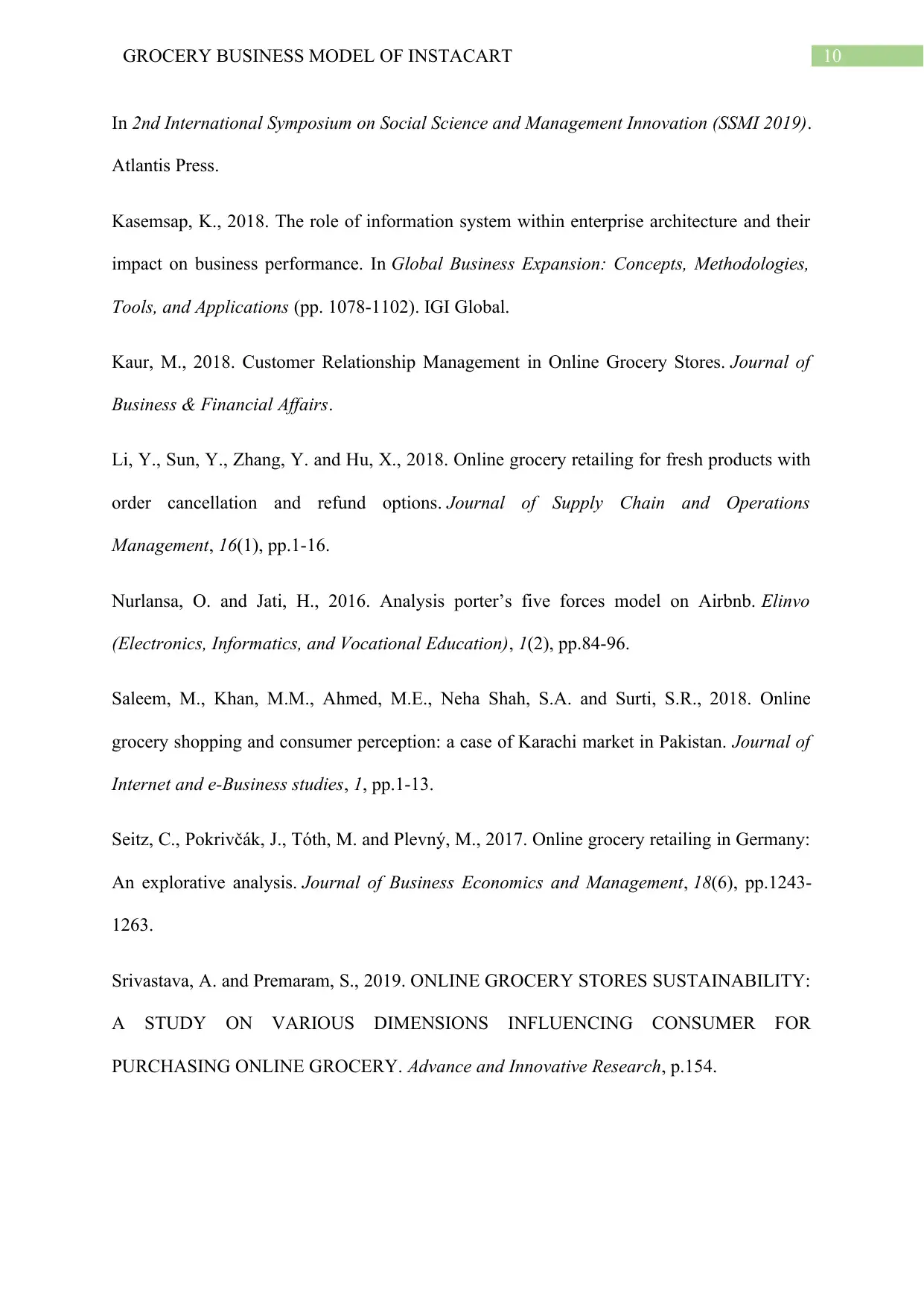
10GROCERY BUSINESS MODEL OF INSTACART
In 2nd International Symposium on Social Science and Management Innovation (SSMI 2019).
Atlantis Press.
Kasemsap, K., 2018. The role of information system within enterprise architecture and their
impact on business performance. In Global Business Expansion: Concepts, Methodologies,
Tools, and Applications (pp. 1078-1102). IGI Global.
Kaur, M., 2018. Customer Relationship Management in Online Grocery Stores. Journal of
Business & Financial Affairs.
Li, Y., Sun, Y., Zhang, Y. and Hu, X., 2018. Online grocery retailing for fresh products with
order cancellation and refund options. Journal of Supply Chain and Operations
Management, 16(1), pp.1-16.
Nurlansa, O. and Jati, H., 2016. Analysis porter’s five forces model on Airbnb. Elinvo
(Electronics, Informatics, and Vocational Education), 1(2), pp.84-96.
Saleem, M., Khan, M.M., Ahmed, M.E., Neha Shah, S.A. and Surti, S.R., 2018. Online
grocery shopping and consumer perception: a case of Karachi market in Pakistan. Journal of
Internet and e-Business studies, 1, pp.1-13.
Seitz, C., Pokrivčák, J., Tóth, M. and Plevný, M., 2017. Online grocery retailing in Germany:
An explorative analysis. Journal of Business Economics and Management, 18(6), pp.1243-
1263.
Srivastava, A. and Premaram, S., 2019. ONLINE GROCERY STORES SUSTAINABILITY:
A STUDY ON VARIOUS DIMENSIONS INFLUENCING CONSUMER FOR
PURCHASING ONLINE GROCERY. Advance and Innovative Research, p.154.
In 2nd International Symposium on Social Science and Management Innovation (SSMI 2019).
Atlantis Press.
Kasemsap, K., 2018. The role of information system within enterprise architecture and their
impact on business performance. In Global Business Expansion: Concepts, Methodologies,
Tools, and Applications (pp. 1078-1102). IGI Global.
Kaur, M., 2018. Customer Relationship Management in Online Grocery Stores. Journal of
Business & Financial Affairs.
Li, Y., Sun, Y., Zhang, Y. and Hu, X., 2018. Online grocery retailing for fresh products with
order cancellation and refund options. Journal of Supply Chain and Operations
Management, 16(1), pp.1-16.
Nurlansa, O. and Jati, H., 2016. Analysis porter’s five forces model on Airbnb. Elinvo
(Electronics, Informatics, and Vocational Education), 1(2), pp.84-96.
Saleem, M., Khan, M.M., Ahmed, M.E., Neha Shah, S.A. and Surti, S.R., 2018. Online
grocery shopping and consumer perception: a case of Karachi market in Pakistan. Journal of
Internet and e-Business studies, 1, pp.1-13.
Seitz, C., Pokrivčák, J., Tóth, M. and Plevný, M., 2017. Online grocery retailing in Germany:
An explorative analysis. Journal of Business Economics and Management, 18(6), pp.1243-
1263.
Srivastava, A. and Premaram, S., 2019. ONLINE GROCERY STORES SUSTAINABILITY:
A STUDY ON VARIOUS DIMENSIONS INFLUENCING CONSUMER FOR
PURCHASING ONLINE GROCERY. Advance and Innovative Research, p.154.
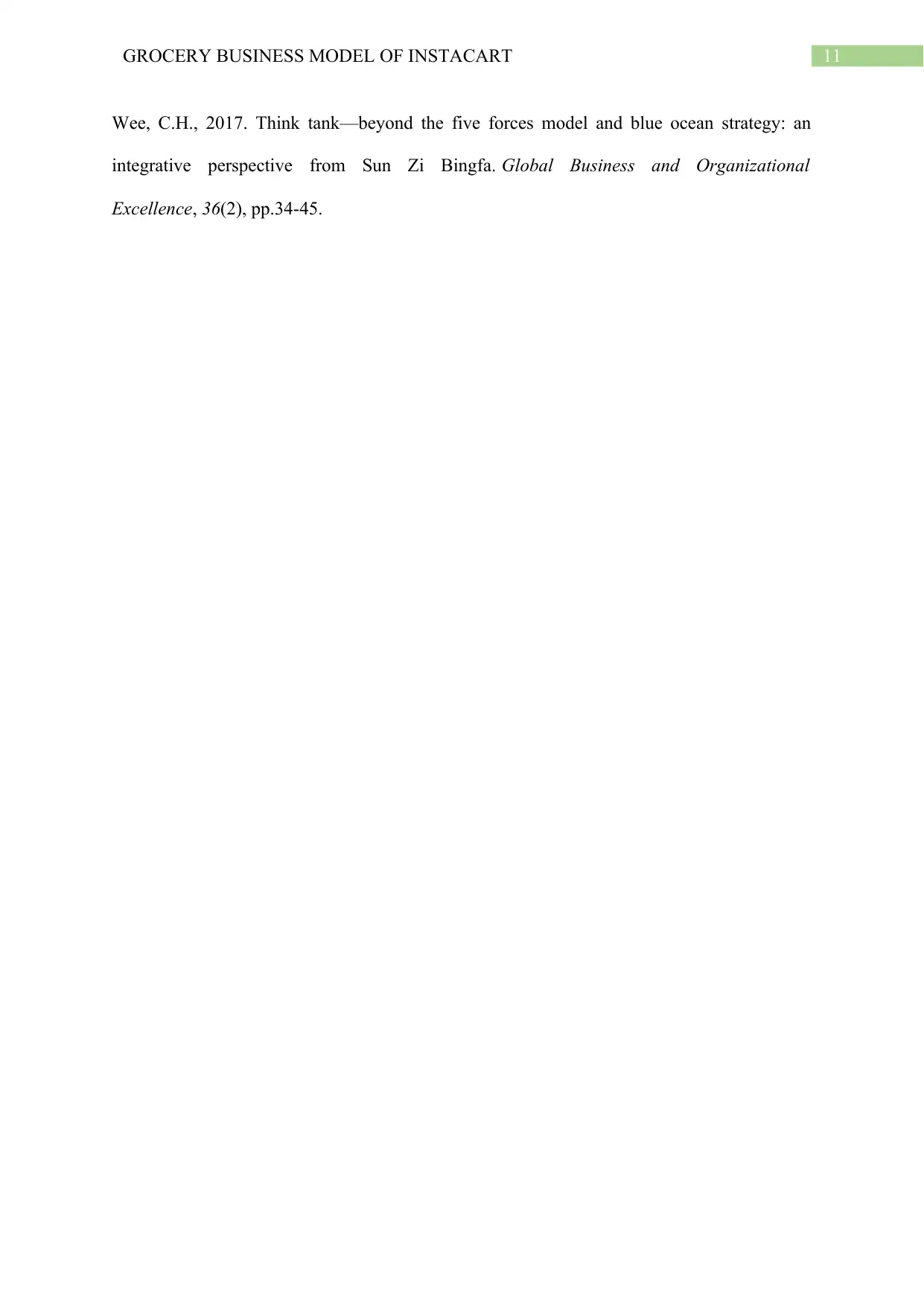
11GROCERY BUSINESS MODEL OF INSTACART
Wee, C.H., 2017. Think tank—beyond the five forces model and blue ocean strategy: an
integrative perspective from Sun Zi Bingfa. Global Business and Organizational
Excellence, 36(2), pp.34-45.
Wee, C.H., 2017. Think tank—beyond the five forces model and blue ocean strategy: an
integrative perspective from Sun Zi Bingfa. Global Business and Organizational
Excellence, 36(2), pp.34-45.
⊘ This is a preview!⊘
Do you want full access?
Subscribe today to unlock all pages.

Trusted by 1+ million students worldwide
1 out of 12
Related Documents
Your All-in-One AI-Powered Toolkit for Academic Success.
+13062052269
info@desklib.com
Available 24*7 on WhatsApp / Email
![[object Object]](/_next/static/media/star-bottom.7253800d.svg)
Unlock your academic potential
Copyright © 2020–2025 A2Z Services. All Rights Reserved. Developed and managed by ZUCOL.





